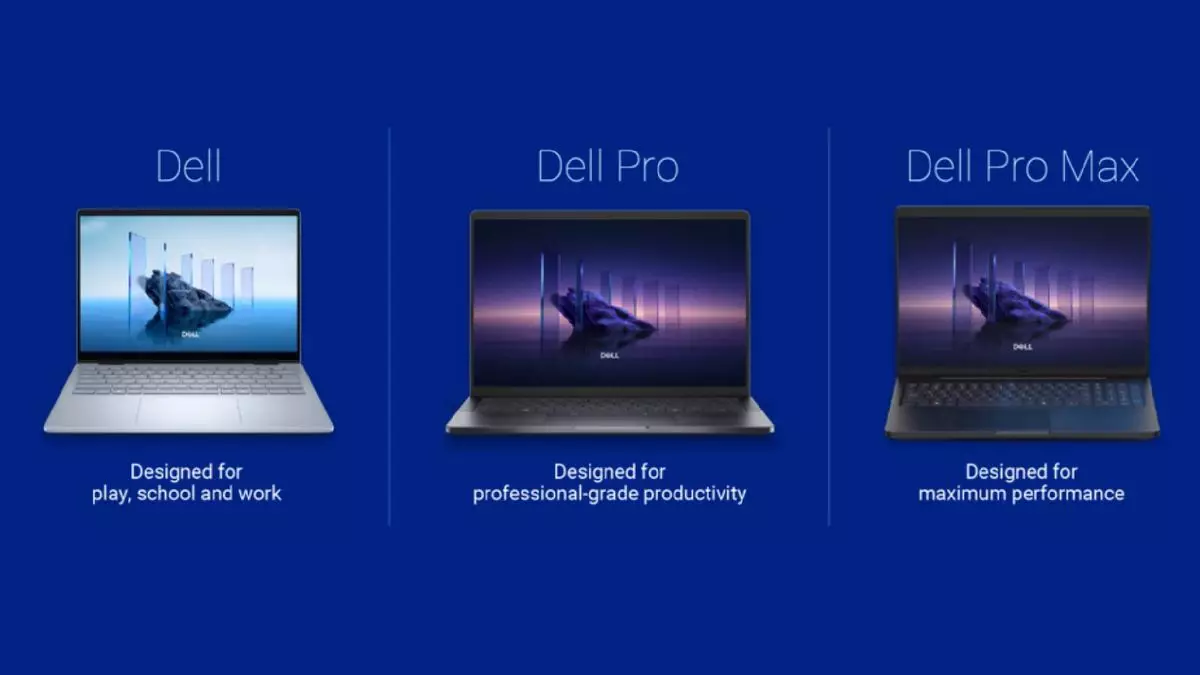Dell Technologies has undergone a significant rebranding initiative aimed at rationalizing its product offerings. Renowned for its expansive range of personal computing devices, the Texas-based company has faced criticism in the past for its somewhat convoluted branding. In an effort to enhance consumer understanding and streamline the purchasing journey, Dell is now categorizing its products into three distinct tiers: Dell, Dell Pro, and Dell Pro Max. This rebranding represents a strategic pivot not only in product nomenclature but also in how Dell positions itself in a crowded market.
At the base level, the brand name “Dell” has been retained and transformed into a catch-all category designed to appeal to general consumers across various contexts such as gaming, education, and everyday work tasks. This new foundational category effectively replaces the Inspiron brand, which had previously been a mainstay for many years. Above the standard Dell category is the Dell Pro line, tailored specifically for professionals who demand productivity and robust performance from their devices. Finally, the Dell Pro Max tier promises the highest performance capabilities, targeting power users and demanding workloads.
This strategic simplification not only aids consumers in navigating their choices but also strengthens the overall brand identity of Dell. By ensuring that each tier conveys its intended audience—whether for casual users, professionals, or high-end users—Dell is attempting to craft a coherent narrative around its products.
With reports indicating that nearly 74% of consumers abandon technology purchases due to feelings of overwhelm, Dell’s new branding strategy is a calculated response to this widespread phenomenon. The complexity of existing product lines can detract from the consumer experience, leading to frustration and hesitation. By establishing a straightforward tier system, Dell aims to minimize confusion, making it easier for buyers to identify the right products that align with their needs.
The new branding will encompass a range of devices, from laptops to desktops, displays, accessories, and even services. By adopting a unified approach, Dell seeks to eliminate the anxiety often associated with technology shopping. While some skeptics may question the long-term efficacy of this approach, it undeniably offers a fresh perspective on a traditionally complex aspect of tech retail.
Dell’s Technological Advances
In conjunction with this branding overhaul, Dell is also placing significant emphasis on its technical capabilities, particularly in the context of artificial intelligence (AI). The upcoming Dell Plus lineup highlights advancements in processing power, featuring Intel’s Core Ultra Series 2 chips along with offerings from AMD and Qualcomm. By showcasing these innovations alongside its branding strategy, Dell reinforces its commitment to remaining at the forefront of technology trends.
Scheduled for release, the Dell Plus laptops will be available from February, starting at $999, while the Dell Pro series begins rolling out immediately. This strategic timing aligns with Dell’s marketing push, allowing the brand to capitalize on its new identity while also highlighting its advancements in technology.
A Nod to Competitors
Interestingly, Dell’s rebranding efforts have invited comparisons to Apple’s own nomenclature, particularly with the use of “Pro” and “Pro Max” in product designations. The familiarity of such terminology can be advantageous, as it provides immediate recognition among consumers who may already be accustomed to Apple’s structured branding. In an industry often marked by confusing model names and variances, Dell’s embrace of this straightforward approach also reflects a broader industry trend towards clarity.
By incorporating recognizable terminology, Dell may not only simplify its branding but potentially leverage a sense of reliability and familiarity that Apple’s established products exude. However, this strategy is not without risks; distinguishing itself amidst existing tech giants while adopting similar branding could lead to challenges in differentiation.
Ultimately, Dell’s rebranding initiative appears to represent a positive step forward in addressing consumer confusion and enhancing the overall purchasing experience. By simplifying its product categories and reinforcing technological advancements, Dell aims to strengthen its market position in an increasingly competitive landscape. The success of this strategy remains to be seen, but the focus on clarity and understanding could well position Dell favorably among consumers looking for straightforward, effective technology solutions. In a world where extensive choices often lead to paralysis, Dell’s new approach could not only guide decision-making but potentially reshape the future of technology branding.


Leave a Reply